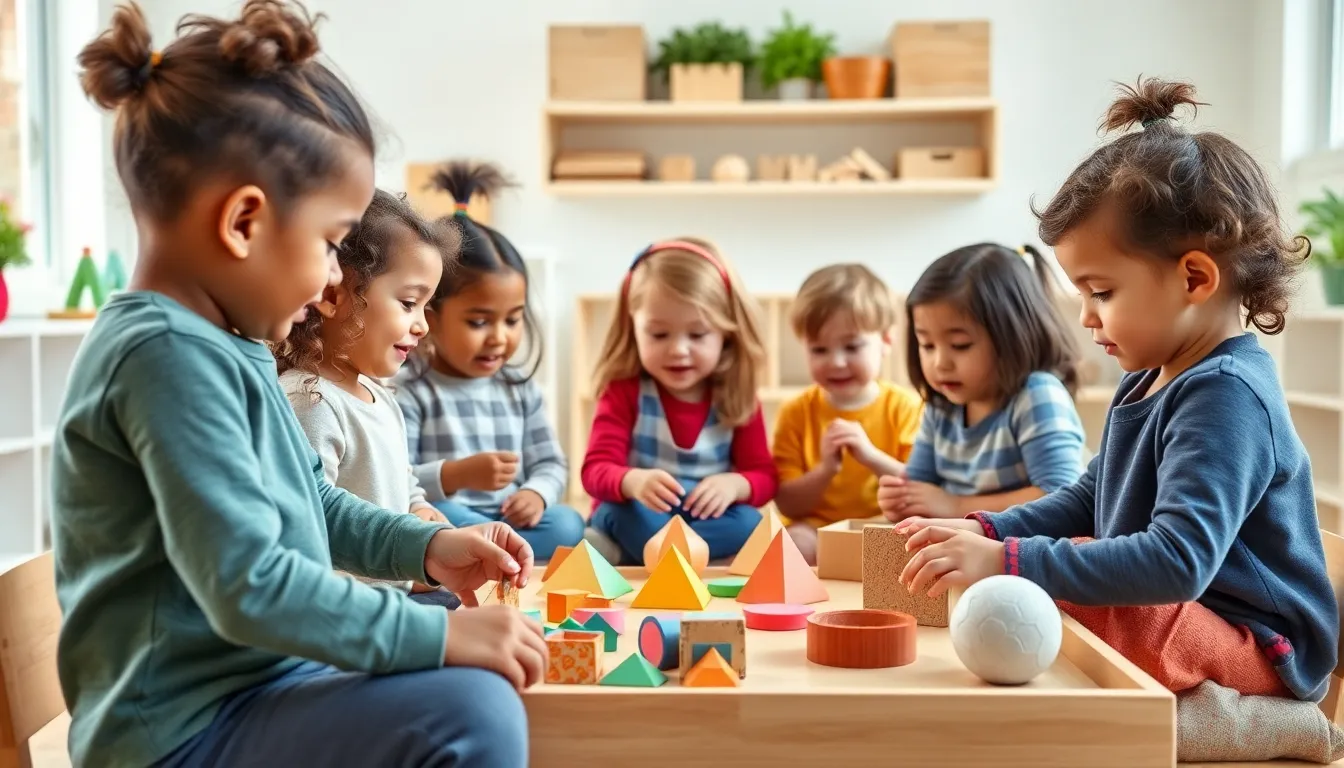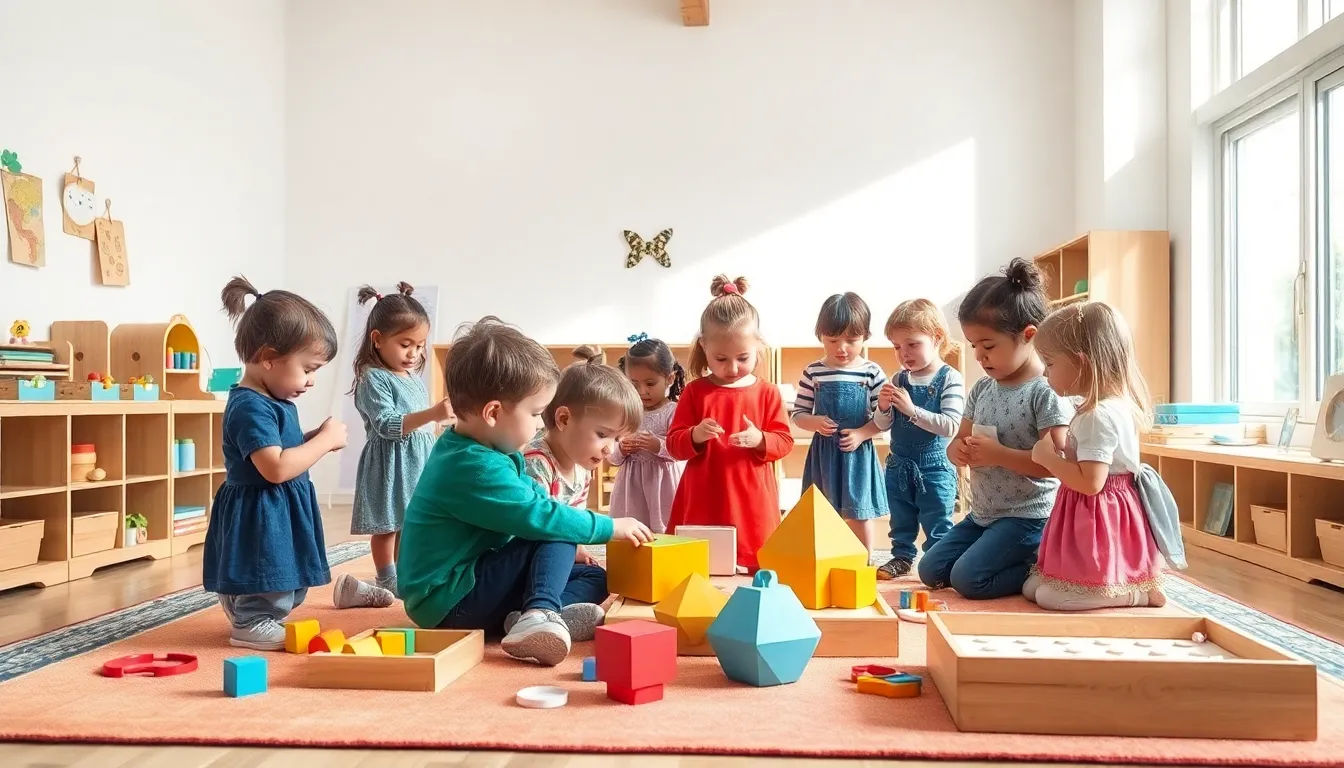Montessori principles have transformed the landscape of education, emphasizing a child-centered approach that nurtures independence and creativity. Developed by Dr. Maria Montessori over a century ago, these principles encourage children to explore their interests at their own pace, fostering a love for learning that lasts a lifetime.
In a Montessori environment, children engage with specially designed materials that promote hands-on learning and critical thinking. The role of the teacher shifts from traditional instructor to guide, allowing for personalized learning experiences that cater to each child’s unique needs. As more parents and educators recognize the benefits of this innovative approach, understanding Montessori principles becomes essential for fostering a supportive and enriching educational journey.
Table of Contents
ToggleOverview of Montessori Principles
Montessori principles emphasize an educational framework centered around the child’s unique developmental needs. These principles focus on fostering independence, allowing children to engage in self-directed learning. Key aspects of the Montessori approach include:
- Child-Centered Learning
Children take charge of their learning processes, selecting activities that capture their interest within a structured environment.
- Prepared Environment
Classrooms are designed to promote exploration and engagement. Materials are accessible and suited to various developmental stages, encouraging active participation.
- Montessori Materials
Specialized learning tools are available for hands-on experiences. These materials facilitate the understanding of abstract concepts through concrete interactions.
- Role of the Teacher
Educators serve as facilitators rather than traditional instructors. They guide children’s exploration, support their learning journeys, and observe individual progress.
- Respect for the Child
The principles prioritize respecting each child’s pace. This approach recognizes that learners develop at different rates and encourages independence over trend-based learning.
- Mixed-Age Classrooms
Classrooms often group children of varying ages, fostering collaboration, peer learning, and social skills.
- Focus on the Whole Child
Education encompasses emotional, social, physical, and cognitive development, promoting well-rounded growth.
Montessori principles create environments that nurture curiosity and a lifelong passion for learning. Understanding these principles provides insights into enhancing educational experiences for children.
Core Elements of Montessori Education

Core elements of Montessori education include child-centered learning and hands-on learning materials. These components create an engaging and supportive environment conducive to individual growth.
Child-Centered Learning
Child-centered learning places the child at the forefront of education. Children choose their activities, guiding their learning according to their interests. This autonomy fosters independence and critical thinking. The role of the teacher shifts to that of a facilitator, observing and supporting each child’s unique interests and needs. In this environment, children learn at their own pace, enhancing their ability to engage with and retain information.
Hands-On Learning Materials
Hands-on learning materials play a pivotal role in the Montessori approach. These specially designed tools encourage exploration and manipulation, strengthening understanding of abstract concepts through tangible interactions. Examples include geometric shapes, sensorial materials like texture boards, and practical life tools such as pouring and sorting items. These materials promote cognitive development, fine motor skills, and problem-solving abilities, enriching the learning experience.
The Role of the Educator
In Montessori education, the educator’s role shifts from traditional teaching to a supportive guide, fostering independence in children. This approach cultivates an enriching learning atmosphere where children can explore and thrive.
Guide vs. Instructor
Educators in Montessori settings act as guides rather than traditional instructors. They observe children’s interests and facilitate learning by providing appropriate resources and opportunities for exploration. This supportive role empowers children to take initiative in their learning while developing critical thinking skills. Guiding includes offering gentle feedback, asking open-ended questions, and encouraging problem-solving rather than delivering direct instruction. This process fosters self-confidence, allows for personalized learning experiences, and promotes a deeper understanding of concepts.
Creating a Prepared Environment
Creating a prepared environment is crucial for effective Montessori education. This environment features accessible materials arranged to promote independence and exploration. Educators design spaces that encourage engagement, creativity, and collaboration among children. Materials align with developmental needs, allowing children to choose activities suited to their interests and abilities. Educators regularly evaluate and adapt the environment, ensuring it remains inviting and conducive to learning. Elements such as natural light, open spaces, and practical materials enhance the overall experience, enabling children to learn through discovery and self-directed activity.
Benefits of Montessori Principles
Montessori principles offer numerous benefits that enhance children’s learning experiences. These benefits stem from the child-centered approach and the unique environment fostered by the Montessori method.
Development of Independence
Independence thrives in Montessori settings, where children engage in self-directed activities. Children choose tasks based on interests and readiness, promoting self-confidence and decision-making skills. This autonomy encourages responsibility, as children learn to manage their own learning processes. A study by the American Montessori Society found that students in Montessori environments demonstrate higher levels of self-regulation compared to peers in traditional classrooms. In this manner, Montessori principles cultivate a sense of ownership over learning, essential for lifelong success.
Fostering Creativity and Critical Thinking
Creativity and critical thinking flourish within the Montessori framework, grounded in hands-on learning. Montessori materials encourage experimentation, exploration, and problem-solving, allowing children to discover solutions independently. An example includes using blocks to construct unique structures, which promotes spatial reasoning and innovative thinking. In addition, mixed-age classrooms foster collaboration, where older children mentor younger peers. This dynamic nurtures diverse perspectives, enhancing both creative and analytical skills. Research indicates that children exposed to Montessori education often score higher on assessments measuring creativity and critical thinking abilities, reinforcing the method’s effectiveness in preparing children for future challenges.
Challenges and Criticisms
Montessori principles face various challenges and criticisms, often stemming from misunderstandings and implementation issues. Awareness of these challenges is essential for educators and parents navigating this approach.
Misinterpretations of Montessori Principles
Misinterpretations frequently arise regarding Montessori principles. Some individuals view Montessori education as unstructured play, underestimating its emphasis on purposeful learning. Critics may argue that children lack boundaries or guidance within this framework, failing to recognize the role of educators as facilitators. Montessori education encourages exploration and independence but maintains structure through thoughtful materials and lesson plans. It’s vital to clarify that Montessori environments promote self-directed learning within a supportive context, striking a balance between freedom and guidance.
Implementing Montessori in Traditional Settings
Implementing Montessori principles in traditional settings presents challenges. Strain often occurs in adapting the Montessori method alongside conventional education models. Traditional classrooms emphasize standardized testing and rigid curricula, which contradicts the Montessori focus on individualized learning. Achieving the desired outcomes requires educators to adjust instructional strategies, incorporate materials, and foster an environment conducive to exploration. Resistance from stakeholders, including educators and parents, may hinder effective implementation. Successful adaptation requires ongoing training to ensure that educators fully understand and effectively apply Montessori principles despite existing structural constraints.
Montessori principles offer a unique approach to education that prioritizes the child’s individual needs and interests. By fostering independence and creativity in a prepared environment, children are empowered to take charge of their learning journey. This method not only enhances cognitive skills but also nurtures emotional and social development.
As educators and parents embrace these principles, they can create enriching experiences that cultivate a lifelong passion for learning. While challenges exist in implementing Montessori methods within traditional settings, understanding these principles can lead to more effective educational practices. Ultimately, the Montessori approach equips children with the skills necessary to thrive in an ever-changing world.




